(February – April 1952, Black Magic #9 – #11)
I cannot supply sales figures so I have to look for other indications for how popular Simon and Kirby titles were. Fortunately Simon and Kirby had a modus operandi when it came to releasing new titles (actually it may have been the publishers who were responsible). New titles were released as bimonthlies but if after a period the titles sales seemed to warrant it the title could become a monthly or a new title of the same genre would be created. Black Magic had been a bimonthly for 16 months when it was converted to a monthly. Thus we can safely conclude that sales of Black Magic were good at least at this point in time.
As was true with the concurrent romance titles (Chapter 18 of The Art of Romance), Jack Kirby was producing less then his normal amount of pages of art with most of the work being done by Mort Meskin. In one respect Kirby still was the most important artist in that he did all the covers and the lead story for the two issues (#10 and #11) of the three covered in this chapter. But in terms of number of pages of art, Jack did only 18 pages as compared to the 34 pages done by Mort. After Mort and Jack come George Roussos (14 pages) and John Prentice (13 pages). Four other artists only supplied a single story; Marvin Stein (8 pages), Bill Draut (7 pages) and two unidentified artists (4 and 5 pages).
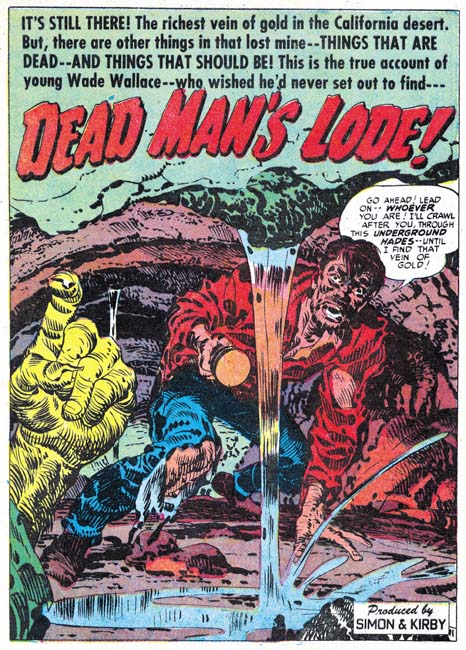
Black Magic #10 (March 1952) “Dead Man’s Lode”, art by Jack Kirby
While Kirby may not have done as much art as he had a year or so ago, what he produced was still top rate stuff. The splash for “Dead Man’s Lode” is a particularly engaging image. Not much in it just a man struggling through a tunnel and a hand beckoning him on. But of course such a simplistic description hardly does justice to what Jack drew. Kirby often brought interest into what for another artist might have been a banal scene. Here the drama is supplied by the man’s torn clothing, stooped posture and rugged features. I particularly like the way the pouring water divides the composition and how streaks of brushwork both suggest the optical distortions as well as the flow of the water.
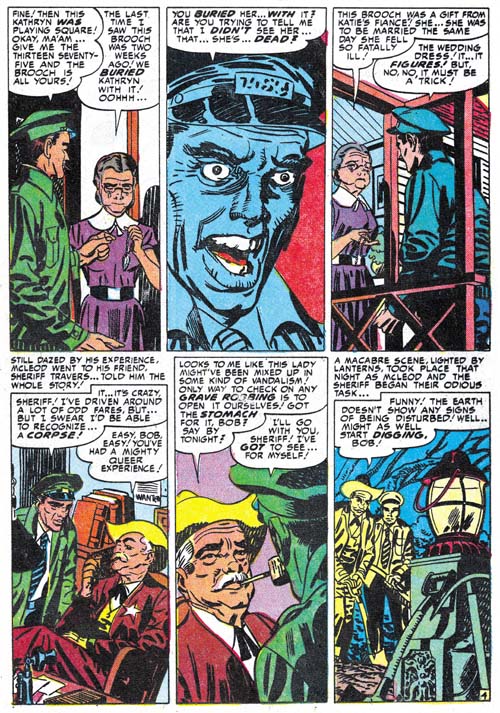
Black Magic #11 (April 1952) “Drop Me Of At the Cemetery” page 4, art by Mort Meskin
I could not resist providing another example of Mort’s use of tall narrow panels. Leonard Starr used them earlier then Meskin, and used the quite well I might add. But Mort’s use of narrow panels was very remarkable. I must admit as I review Mort’s work in Black Magic and the romance titles I cannot help but feel Meskin was more at home with the horror genre. You pretty much never see in Mort’s romance work such a well worked out close-up as in panel 2 but they are not very rare in Black Magic.
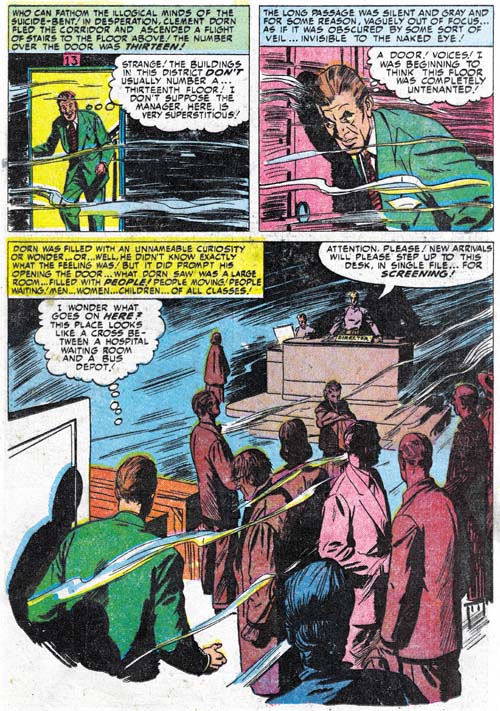
Black Magic #11 (April 1952) “The Thirteenth Floor” page 2, art by John Prentice
John Prentice did a lot of romance work for Simon and Kirby so it is easy to overlook his contributions in other genre. I find his art in Black Magic quite satisfying. I have previously discussed “The Thirteenth Floor” (Alternate Takes, The Thirteenth Floor) and will not repeat it here other then to note that use of a splash-like story panel is unusual for Prentice. Despite what I feel is the high quality of his Black Magic work, John did not produce many stories for the title. Another Prentice story would not appear in Black Magic until 9 months later.
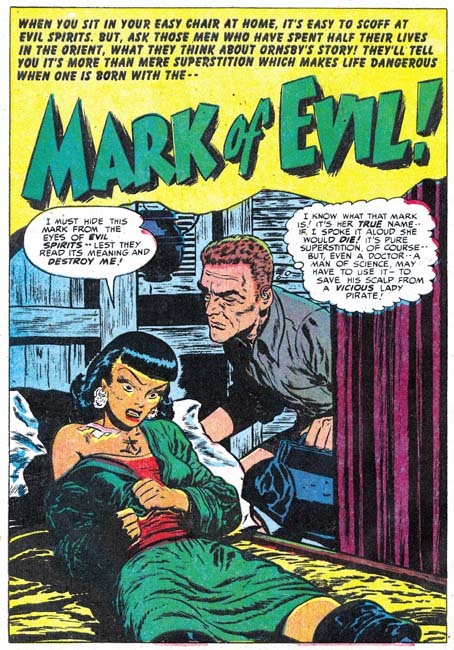
Black Magic #9 (February 1952) “Mark of Evil”, art by Bill Draut
A ruthless but beautiful Chinese pirate; what’s not to like despite being a somewhat predictable story. Draut seemed to relish the change of pace afforded by Black Magic from his frequent romance work.
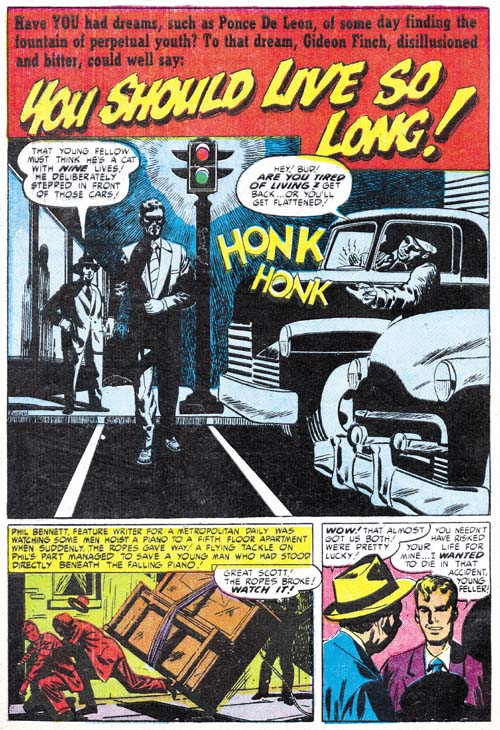
Black Magic #9 (February 1952) “You Should Live So Long”, art by George Roussos
George Roussos appeared to get a greater portion of work for Black Magic as compared to the romance titles. Frankly he is not as talented as some of the other studio artists. His work has a certain crudeness that while quite acceptable in the horror genre detracts that from his romance art. Presumably that is why he is more often seen in Black Magic. Despite my criticism of his art, in at least on respect Roussos is quite effective and that is in his use of blacks. The splash panel for “You Should Live So Long” is a good example of George’s interesting use of shadows.
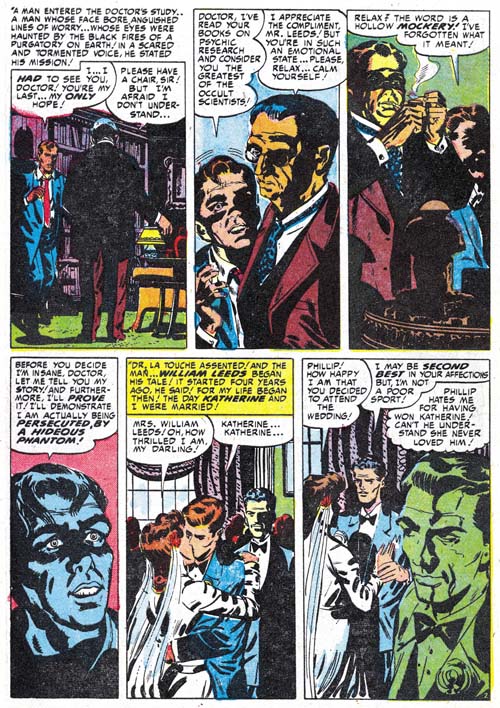
Black Magic #11 (April 1952) “Through All Eternity” page 2, art by George Roussos
I recently wrote about a story that while signed by Roussos looked like it was based on layouts provided by Mort Meskin (Art of Romance, Chapter 18). One of the things I noted in that story (“The Great Indoors”) was the use of tall narrow panels that Meskin was fond of using at that time. Well “Through All Eternity” also has a page with similar panels and so the question arises whether Mort did layouts for this story as well. While some of the faces in “The Great Indoors” looked distinctly like they were drawn by Meskin, I find no such overt Meskin drawing in “Through Al Eternity”. Further while three of the panels (4 to 6) of page 2 look like Meskin could have laid them out, the composition of the upper three panels seems inferior to Mort’s typical efforts. On a whole I am included to say that these are not Meskin layouts and Roussos was just trying to pick up some of Mort’s techniques.
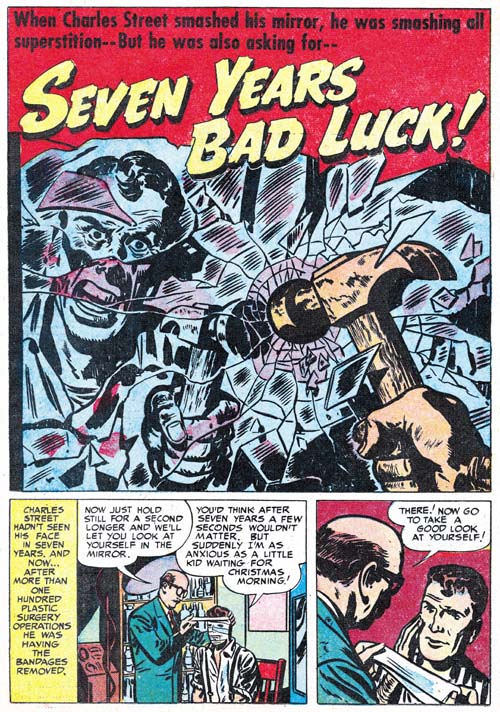
Black Magic #10 (March 1952) “Seven Years Bad Luck”, art by Marvin Stein
My database has 6 Black Magic stories drawn by Marvin Stein but they are all from the second run of the title (1957 – 1958). “Seven Years Bad Luck” is unsigned but there are quite enough examples of typical Stein drawing style, such as the man on the right in the last panel, that it can confidentially be attributed to Marvin. By this time Stein was only occasionally providing work for Simon and Kirby productions but he was very active in Prize crime titles (Headline and Justice Traps the Guilty) having in fact become the primary artist. Stein also made appearances in Prize Comics Western although not nearly as often. Marvin had developed a style very suited for the crime and western genre, and he puts it to good effect in this Black Magic tale as well.

Black Magic #9 (February 1952) “The Man in the Judge’s Chair”, art by J. G.
There are two mystery artists in the Black Magic issues covered in this chapter. One particularly tantalizing one is the one who did “The Man in the Judge’s Chair”. I say that not because of the art, which is good but not great, but because it is signed with just initials (J. G.). I have a small list of candidates with those initials who worked during this period:
- Joe Gagliardi
- Joe Gallagher
- Jim Gary
- Joe Gevanter
- Joe Giella
- John Guinta
- Jerry Grandenetti
- Joe Greene
I am completely unfamiliar with four of them and so I will have to do more research. John Guinta did some work for Simon and Kirby in 1949 (chapter 9 of Art of Romance and chapter 7 of It’s A Crime) but unless his style has changed considerably he was not the artist. Jerry Grandenetti worked with Joe Simon in the 70’s and his comic book career actually goes back far enough. I have not seen much of Grandenetti’s early work and will not rule him out entirely but I do not think he is a good match either. My database shows Joe Gevanter as the artist for a story in Prize Comics Western #104 (March 1954) but I now question that attribution. The piece is signed Gevanter and Severin and that order usually means Gevanter was the penciller and Severin the inker but it seems odd that Severin would ink another artist work when he generally did not ink his own pencils. Further the drawing style is so close to Severin’s that either John’s inking completely overwhelmed Joe’s pencils or in fact Gevanter was the inker to Severin pencils. Currently I accept the latter deduction and I have found no indications that Gevanter penciled any other comic book so I do not consider him the artist of “The Man in the Judge’s Chair”.
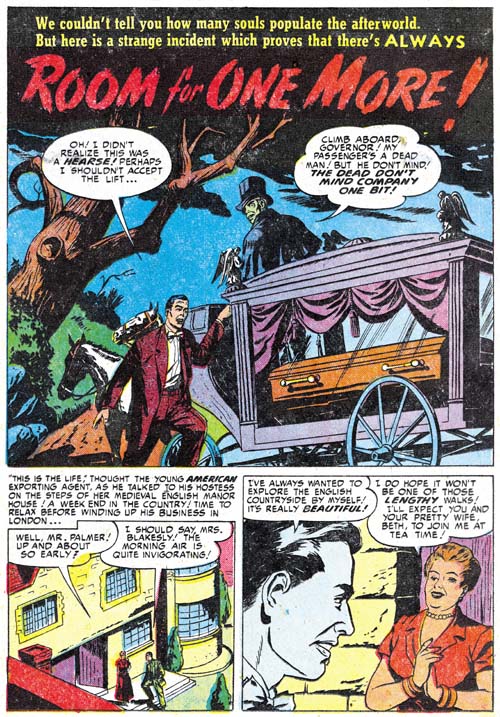
Black Magic #11 (April 1952) “Room for One More”, art by unidentified artist
The other unattributed story is “Room for One More”. Again the art really is neither bad nor great but it would be nice to know who drew it. Unfortunately at this time I cannot even offer a suggestion.
The Little Shop of Horrors, Chapter 1 (#1 – 3), Expanding Their Fields
The Little Shop of Horrors, Chapter 2 (#4 – 6), Up and Running
The Little Shop of Horrors, Chapter 3 (#7 – 8), The Same Old Gang
The Little Shop of Horrors, Chapter 5 (#12 – 14), New Faces
The Little Shop of Horrors, Chapter 6 (#15 – 17), Mix Bag
The Little Shop of Horrors, Chapter 7 (#18 – 20), Kirby Returns
The Little Shop of Horrors, Chapter 8 (#21 – 23), The Gang’s All Here
The Little Shop of Horrors, Chapter 9 (#24 – 26), The Party’s Ovetr
The Little Shop of Horrors, Chapter 10 (#27 – 29), A Special Visitor
The Little Shop of Horrors, Chapter 11 (#30 – 33), The End


The work signed J.G. Looks like Infantino’s work to me. Could it be J.I. instead of J.G. and be Carmine’s brother Jimmy?
It may not be clear in the image I provided (the problem with the low resolutions necessary for the Internet) but it is a J.G. not J.I. Jimmy Infantino’s style was not like Carmines, I guess style is not in the genes.
My first thought on seeing the art was Jerry Grandenetti, for what its worth.